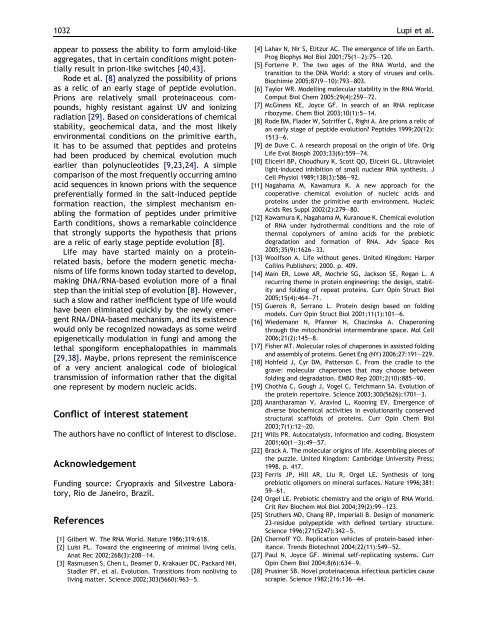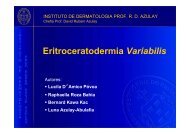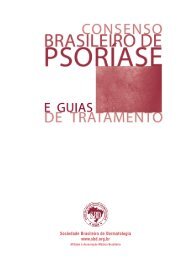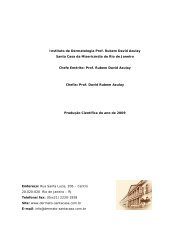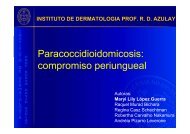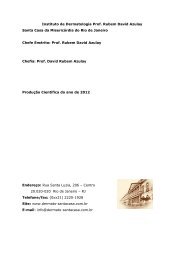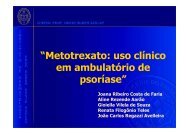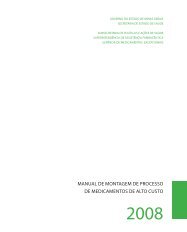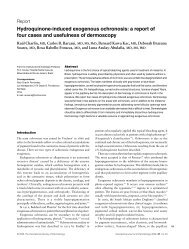Are prions related to the emergence of early life? - instituto de ...
Are prions related to the emergence of early life? - instituto de ...
Are prions related to the emergence of early life? - instituto de ...
You also want an ePaper? Increase the reach of your titles
YUMPU automatically turns print PDFs into web optimized ePapers that Google loves.
1032 Lupi et al.<br />
appear <strong>to</strong> possess <strong>the</strong> ability <strong>to</strong> form amyloid-like<br />
aggregates, that in certain conditions might potentially<br />
result in prion-like switches [40,43].<br />
Ro<strong>de</strong> et al. [8] analyzed <strong>the</strong> possibility <strong>of</strong> <strong>prions</strong><br />
as a relic <strong>of</strong> an <strong>early</strong> stage <strong>of</strong> pepti<strong>de</strong> evolution.<br />
Prions are relatively small proteinaceous compounds,<br />
highly resistant against UV and ionizing<br />
radiation [29]. Based on consi<strong>de</strong>rations <strong>of</strong> chemical<br />
stability, geochemical data, and <strong>the</strong> most likely<br />
environmental conditions on <strong>the</strong> primitive earth,<br />
it has <strong>to</strong> be assumed that pepti<strong>de</strong>s and proteins<br />
had been produced by chemical evolution much<br />
earlier than polynucleoti<strong>de</strong>s [9,23,24]. A simple<br />
comparison <strong>of</strong> <strong>the</strong> most frequently occurring amino<br />
acid sequences in known <strong>prions</strong> with <strong>the</strong> sequence<br />
preferentially formed in <strong>the</strong> salt-induced pepti<strong>de</strong><br />
formation reaction, <strong>the</strong> simplest mechanism enabling<br />
<strong>the</strong> formation <strong>of</strong> pepti<strong>de</strong>s un<strong>de</strong>r primitive<br />
Earth conditions, shows a remarkable coinci<strong>de</strong>nce<br />
that strongly supports <strong>the</strong> hypo<strong>the</strong>sis that <strong>prions</strong><br />
are a relic <strong>of</strong> <strong>early</strong> stage pepti<strong>de</strong> evolution [8].<br />
Life may have started mainly on a protein<strong>related</strong><br />
basis, before <strong>the</strong> mo<strong>de</strong>rn genetic mechanisms<br />
<strong>of</strong> <strong>life</strong> forms known <strong>to</strong>day started <strong>to</strong> <strong>de</strong>velop,<br />
making DNA/RNA-based evolution more <strong>of</strong> a final<br />
step than <strong>the</strong> initial step <strong>of</strong> evolution [8]. However,<br />
such a slow and ra<strong>the</strong>r inefficient type <strong>of</strong> <strong>life</strong> would<br />
have been eliminated quickly by <strong>the</strong> newly emergent<br />
RNA/DNA-based mechanism, and its existence<br />
would only be recognized nowadays as some weird<br />
epigenetically modulation in fungi and among <strong>the</strong><br />
lethal spongiform encephalopathies in mammals<br />
[29,38]. Maybe, <strong>prions</strong> represent <strong>the</strong> reminiscence<br />
<strong>of</strong> a very ancient analogical co<strong>de</strong> <strong>of</strong> biological<br />
transmission <strong>of</strong> information ra<strong>the</strong>r that <strong>the</strong> digital<br />
one represent by mo<strong>de</strong>rn nucleic acids.<br />
Conflict <strong>of</strong> interest statement<br />
The authors have no conflict <strong>of</strong> interest <strong>to</strong> disclose.<br />
Acknowledgement<br />
Funding source: Cryopraxis and Silvestre Labora<strong>to</strong>ry,<br />
Rio <strong>de</strong> Janeiro, Brazil.<br />
References<br />
[1] Gilbert W. The RNA World. Nature 1986;319:618.<br />
[2] Luisi PL. Toward <strong>the</strong> engineering <strong>of</strong> minimal living cells.<br />
Anat Rec 2002;268(3):208–14.<br />
[3] Rasmussen S, Chen L, Deamer D, Krakauer DC, Packard NH,<br />
Stadler PF, et al. Evolution. Transitions from nonliving <strong>to</strong><br />
living matter. Science 2002;303(5660):963–5.<br />
[4] Lahav N, Nir S, Elitzur AC. The <strong>emergence</strong> <strong>of</strong> <strong>life</strong> on Earth.<br />
Prog Biophys Mol Biol 2001;75(1–2):75–120.<br />
[5] Forterre P. The two ages <strong>of</strong> <strong>the</strong> RNA World, and <strong>the</strong><br />
transition <strong>to</strong> <strong>the</strong> DNA World: a s<strong>to</strong>ry <strong>of</strong> viruses and cells.<br />
Biochimie 2005;87(9–10):793–803.<br />
[6] Taylor WR. Mo<strong>de</strong>lling molecular stability in <strong>the</strong> RNA World.<br />
Comput Biol Chem 2005;29(4):259–72.<br />
[7] McGiness KE, Joyce GF. In search <strong>of</strong> an RNA replicase<br />
ribozyme. Chem Biol 2003;10(1):5–14.<br />
[8] Ro<strong>de</strong> BM, Fla<strong>de</strong>r W, Sotriffer C, Righi A. <strong>Are</strong> <strong>prions</strong> a relic <strong>of</strong><br />
an <strong>early</strong> stage <strong>of</strong> pepti<strong>de</strong> evolution? Pepti<strong>de</strong>s 1999;20(12):<br />
1513–6.<br />
[9] <strong>de</strong> Duve C. A research proposal on <strong>the</strong> origin <strong>of</strong> <strong>life</strong>. Orig<br />
Life Evol Biosph 2003;33(6):559–74.<br />
[10] Eliceiri BP, Choudhury K, Scott QO, Eliceiri GL. Ultraviolet<br />
light-induced inhibition <strong>of</strong> small nuclear RNA syn<strong>the</strong>sis. J<br />
Cell Physiol 1989;138(3):586–92.<br />
[11] Nagahama M, Kawamura K. A new approach for <strong>the</strong><br />
cooperative chemical evolution <strong>of</strong> nucleic acids and<br />
proteins un<strong>de</strong>r <strong>the</strong> primitive earth environment. Nucleic<br />
Acids Res Suppl 2002(2):279–80.<br />
[12] Kawamura K, Nagahama M, Kuranoue K. Chemical evolution<br />
<strong>of</strong> RNA un<strong>de</strong>r hydro<strong>the</strong>rmal conditions and <strong>the</strong> role <strong>of</strong><br />
<strong>the</strong>rmal copolymers <strong>of</strong> amino acids for <strong>the</strong> prebiotic<br />
<strong>de</strong>gradation and formation <strong>of</strong> RNA. Adv Space Res<br />
2005;35(9):1626–33.<br />
[13] Woolfson A. Life without genes. United Kingdom: Harper<br />
Collins Publishers; 2000. p. 409.<br />
[14] Main ER, Lowe AR, Mochrie SG, Jackson SE, Regan L. A<br />
recurring <strong>the</strong>me in protein engineering: <strong>the</strong> <strong>de</strong>sign, stability<br />
and folding <strong>of</strong> repeat proteins. Curr Opin Struct Biol<br />
2005;15(4):464–71.<br />
[15] Guerois R, Serrano L. Protein <strong>de</strong>sign based on folding<br />
mo<strong>de</strong>ls. Curr Opin Struct Biol 2001;11(1):101–6.<br />
[16] Wie<strong>de</strong>mann N, Pfanner N, Chacinska A. Chaperoning<br />
through <strong>the</strong> mi<strong>to</strong>chondrial intermembrane space. Mol Cell<br />
2006;21(2):145–8.<br />
[17] Fisher MT. Molecular roles <strong>of</strong> chaperones in assisted folding<br />
and assembly <strong>of</strong> proteins. Genet Eng (NY) 2006;27:191–229.<br />
[18] Hohfeld J, Cyr DM, Patterson C. From <strong>the</strong> cradle <strong>to</strong> <strong>the</strong><br />
grave: molecular chaperones that may choose between<br />
folding and <strong>de</strong>gradation. EMBO Rep 2001;2(10):885–90.<br />
[19] Chothia C, Gough J, Vogel C, Teichmann SA. Evolution <strong>of</strong><br />
<strong>the</strong> protein reper<strong>to</strong>ire. Science 2003;300(5626):1701–3.<br />
[20] Anantharaman V, Aravind L, Kooning EV. Emergence <strong>of</strong><br />
diverse biochemical activities in evolutionarily conserved<br />
structural scaffolds <strong>of</strong> proteins. Curr Opin Chem Biol<br />
2003;7(1):12–20.<br />
[21] Wills PR. Au<strong>to</strong>catalysis, information and coding. Biosystem<br />
2001;60(1–3):49–57.<br />
[22] Brack A. The molecular origins <strong>of</strong> <strong>life</strong>. Assembling pieces <strong>of</strong><br />
<strong>the</strong> puzzle. United Kingdom: Cambridge University Press;<br />
1998. p. 417.<br />
[23] Ferris JP, Hill AR, Liu R, Orgel LE. Syn<strong>the</strong>sis <strong>of</strong> long<br />
prebiotic oligomers on mineral surfaces. Nature 1996;381:<br />
59–61.<br />
[24] Orgel LE. Prebiotic chemistry and <strong>the</strong> origin <strong>of</strong> RNA World.<br />
Crit Rev Biochem Mol Biol 2004;39(2):99–123.<br />
[25] Stru<strong>the</strong>rs MD, Chang RP, Imperiali B. Design <strong>of</strong> monomeric<br />
23-residue polypepti<strong>de</strong> with <strong>de</strong>fined tertiary structure.<br />
Science 1996;271(5247):342–5.<br />
[26] Chern<strong>of</strong>f YO. Replication vehicles <strong>of</strong> protein-based inheritance.<br />
Trends Biotechnol 2004;22(11):549–52.<br />
[27] Paul N, Joyce GF. Minimal self-replicating systems. Curr<br />
Opin Chem Biol 2004;8(6):634–9.<br />
[28] Prusiner SB. Novel proteinaceous infectious particles cause<br />
scrapie. Science 1982;216:136–44.


